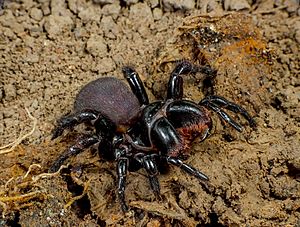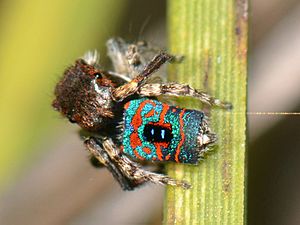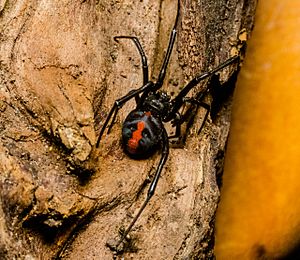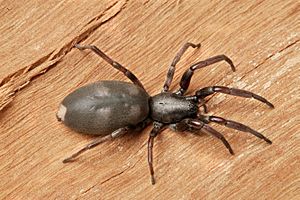Spiders of Australia facts for kids
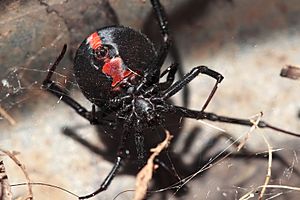
Australia is home to many amazing spiders! Some, like the Sydney Funnel-web and the Redback Spider, have strong venom. Their bites can be very painful. However, most Australian spiders are not dangerous to people. It's important to know that no deaths from spider bites in Australia have been officially confirmed since 1979. Sometimes, news reports make spiders sound scarier than they are.
Contents
Discovering Australian Spiders
Scientists have been studying Australian spiders for a long time. One of the first big books about them was written by L. Koch and E. von Keyserling between 1871 and 1890. They described and drew many spiders they found in nature.
Early collectors helped a lot. Eduard Daemel and Amalie Dietrich gathered spider specimens. Amalie Dietrich spent 10 years in Australia collecting for a museum in Germany.
Later, William Joseph Rainbow became a very important Australian spider expert. He described about 200 new types of spiders! In 1911, he listed all 1,102 spider species known in Australia at that time. Many other experts, like Keith McKeown, Barbara York Main, and Densey Clyne, also wrote books about Australian spiders, helping us learn more about these fascinating creatures.
Types of Australian Spiders
Australia has a huge variety of spider families. Scientists group spiders into families based on their features. There are two main groups of spiders: mygalomorphs and araneomorphs. Mygalomorphs include spiders like tarantulas and trapdoor spiders. Araneomorphs are the more common "true spiders."
Here are just some of the interesting spider families found in Australia:
- Ambush-hunters (Arkyidae)
- Ant-eating Spiders (Zodariidae)
- Assassin Spiders (Archaeidae)
- Australian Funnelweb Spiders (Hexathelidae)
- Australian Tarantulas (Theraphosidae)
- Comb-footed Spiders (Theridiidae)
- Crab Spiders (Thomisidae)
- Daddy Long-legs Spiders (Pholcidae)
- Huntsman Spiders (Sparassidae)
- Jumping Spiders (Salticidae)
- Mouse Spiders (Actinopodidae)
- Net-casting Spiders (Deinopidae)
- Orb-weavers (Araneidae)
- Pirate Spiders (Mimetidae)
- Recluse Spiders (Sicariidae)
- Spitting Spiders (Scytodidae)
- White‐tailed Spiders (Lamponidae)
- Wolf Spiders (Lycosidae)
Amazing Australian Peacock Spiders
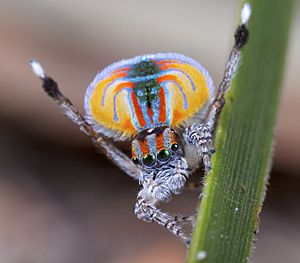
Peacock Spiders are special spiders found only in Australia. They are famous for their incredible mating dances! Male Peacock Spiders have bright, colourful flaps and fringes on their bodies. When they want to impress a female, they lift these flaps and wave their legs. It's like a tiny, colourful show!
There are at least 59 different types of Peacock Spiders in the Maratus group. Each type has its own unique look and dance moves. For example:
- The calcitrans group has many colourful species found in eastern Australia. Males in this group inflate their spinnerets (silk-making organs) during their dance. They also kick one of their third legs from side to side.
- The chrysomelas group includes spiders found in dry areas and tropical northern Australia.
- The mungaich group lives in Western Australia. Males have very wide, bright fans with red and iridescent scales.
- The volans group contains some of the most colourful Peacock Spiders. Their fans have amazing patterns made of different coloured scales.
One type, M. harrisi, was even the subject of a documentary! These tiny spiders are truly one of Australia's natural wonders.
Australia's Famous Spiders: Redback and Funnel-web
The Redback Spider is well-known in Australia. It originally lived in the deserts of South and Western Australia. Now, it has spread across Australia and even to other countries like New Zealand and Japan.
A unique fact about Redback Spiders is that the female sometimes eats the male during mating. This is a form of cannibalism! If a Redback Spider bites you, the most common sign is extreme pain. You might also start sweating a lot around the bite area, and then all over your body. This happens because of how the venom affects your nerves. You might also feel sick or have stomach pain.
For a long time, there was an antivenom for Redback bites. However, recent studies suggest that this antivenom might not be much better than a placebo (a fake treatment). It also carries risks, so doctors don't always recommend it for routine use anymore.
The Sydney Funnel-web Spider (Atrax robustus) is often called one of the world's most dangerous spiders. It lives in an area about 100 km around Sydney. Luckily, no deaths have occurred since an antivenom was created in 1981!
Male Funnel-web Spiders often wander around at night in spring and summer looking for females. They can sometimes end up in houses or even fall into swimming pools. They can survive underwater for a long time! Scientists have even "milked" these spiders for their venom to study it for possible cancer treatments.
White-tailed Spiders: Separating Fact from Myth
You might have heard stories about White-tailed Spiders causing very bad skin wounds. This is a common urban myth, but it's not true! Studies have looked at real White-tailed Spider bites. They found that people usually only feel pain, redness, and itchiness. There were no cases of serious flesh-eating wounds or infections.
White-tailed Spiders are part of the Lampona family. Almost all of the 200 known species in this family live in Australia. The most common ones are Lampona cylindrata and Lampona murina. They look very similar, so it's hard to tell them apart without looking closely at their bodies.
These spiders usually have eight eyes in two rows. Their bodies are often cigar-shaped and can be 3 to 13 mm long. Young White-tailed Spiders often have white marks on their backs.
The myth about their bites started in 1982 when a researcher claimed they caused severe skin problems. This idea spread through some medical articles. However, later research by experts like Geoff Isbister and Mike Gray showed that these claims were not correct.
Daddy Long-legs: The Venom Myth
The Daddy Long-legs Spider (Pholcus phalangioides) is another spider with a popular myth about its venom. The myth says that its venom is super strong, strong enough to kill a person, but its fangs are too small to bite us. This is not true!
This myth might have started because Daddy Long-legs Spiders can actually kill Redback Spiders. They use their long legs to wrap the Redback in silk from a safe distance. Once the Redback is tangled up, the Daddy Long-legs Spider can bite it and wait for it to die before feeding. So, while they can take down a dangerous spider, their venom is not a threat to humans.


